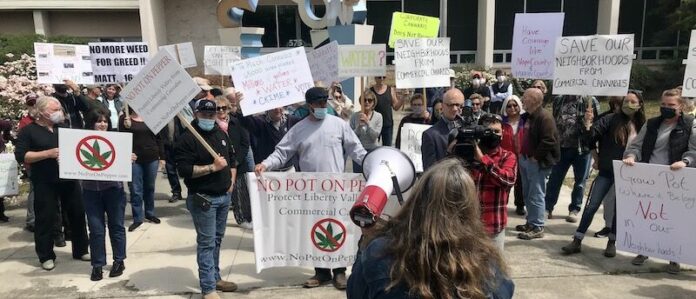
Sonoma County’s conversation over commercial cannabis cultivation hit a big reset Tuesday morning, May 17, when the Sonoma County Board of Supervisors voted unanimously to require themselves to conduct a full-blown programmatic environmental impact report (EIR) prior to completing any updates to the current commercial cannabis cultivation ordinance first adopted in 2018.
“I think we owe an apology,” said Supervisor David Rabbitt. “We haven’t been doing any favors for the (cannabis) industry, neighbors or the county. It’s time to hit a reset. I think we failed.”
Board chair Lynda Hopkins agreed, “Yes, I think we owe an apology and admit we have learned a lesson.”
Efforts by the county leaders to fast-track cannabis cultivation ordinance updates over the past 18 months have been met with orchestrated rural neighbor opposition, growing impatience from growers and, finally, a threatened legal challenge by the law firm, Shute, Mihaly and Weinberger LLP, of San Francisco, representing the Friends of the Mark West Watershed and Save Our Sonoma Neighborhoods.
Following a closed session on Monday about the potential legal challenge, county counsel Robert Pittman said there is a possible “fair argument” that the county’s Mitigated Negative Declaration, claiming staff-proposed ordinance updates would not harm the environment, could likely lead to a court case.
“I think we are back where we were a few years ago when I was favoring a full EIR from the get-go,” said Rabbitt, who was not contradicted by the other four supervisors during the virtual broadcast public hearing.
Tennis Wick, the county’s planning department director, said a programmatic EIR on commercial cannabis cultivation would take 12-18 months and include a series of community town hall sessions, public hearings and final board of supervisors deliberations and votes. Sheryl Bratton, the county’s top administrator, said public policy workshops could likely not be ready to convene until November or December, adding frustration to Hopkins’ and her colleagues’ desires to move everyone to a new set of land use rules to determine where commercial cannabis should be allowed and where it should be prohibited.
Meanwhile, thousands of small growers, including several hundred with open applications, are now facing extended and expensive delays.
“This process has been way too slow,” said a member of the pro-cannabis Hessel Grange during Tuesday public comments. “There is no excuse for this. Your (planning) consultants are too expensive and much too slow.”
There was a brief discussion by the supervisors to place a moratorium on all commercial cultivation applications, but no formal vote was taken. All current and pending grow applications can proceed under existing land use, safety and resource use rules included in the 2018 ordinance, according to county planning staff member Scott Orr.
In January, the county released draft ordinance and the Mitigated Negative Declaration documents, seeking to streamline the application process by installing a “ministerial” process at the agricultural commissioner’s office and reducing the requirements for public hearings and staff reviews. The new proposal sought to allow commercial indoor and mixed light grows on agriculture zone lands and parcels at least 10 acres in size. Property setbacks were required and stringent requirements for habitat protection, water use, safety and shielding from public views were all included.
The supervisors conduced a 180-minute public hearing Tuesday, limiting comments to just 90 seconds per person. As with previous hearings held in April by the county planning commission, the public comments were almost equally divided between concerned rural neighbors and frustrated growers. Several small growers complained they might lose their livelihoods due to delays and competition from growers in other regions of California.
“We’ve already waited way too long,” one grower said. “Somebody should be fired.”
“I think we’re facing a significant pause,” said Supervisor Chris Coursey. “We’re facing significant controversy and I don’t see a good time estimate.”
“How do we fix this administrative timeline and get certainty for our neighbors and growers,” Hopkins asked. Planner Wick said lack of staff and bottlenecks outside the county were contributing to the permit delays. With the new EIR now required, Wick said even more county planning staff will be needed.
“So our cannabis conversation will now continue,” said Supervisor Susan Gorin. “How do we assure neighborhood compatibility and where de we grow it? How do we help start a new industry and help it thrive? Lots of these are young people.”







